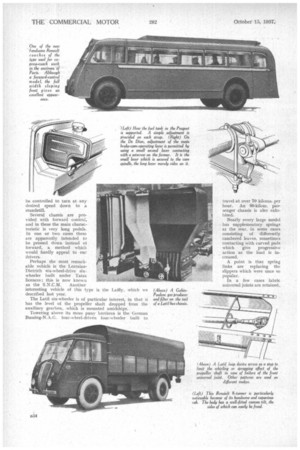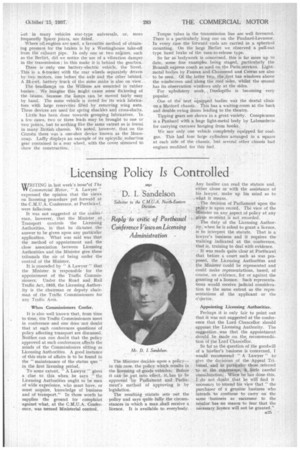FRENCH DESIGN THE DOLDRUMS
Page 50

Page 51

Page 52

Page 53

If you've noticed an error in this article please click here to report it so we can fix it.
Notes by Our. Critic After a Careful Examination of the Commercial-vehkle Exhibits at the Paris Show TAKEN as a whole, the commercial-vehicle section of this year's Paris Show is disappointing. French designers appear to have achieved little in the year since the Show of 1936—at least, it is difficult to find specific results of any such activity in the vehicles and chassis displayed.
As usual, the conspicuous difference between this Show and that of London is in the large number of vehicles equipped with gas producers, whilst oil engines are to be found in considerable • numbers, at least three makers standardizing on building under Gardner licence.
Many Types of Oil Engine.
Panhard Levassor continues its sleeve-valve type. Peugeot and Citroen are using neat little oil engines on • comparatively light chassis, Berliet a type with an antechamber immediately above the flat piston, Willerne utilizes the Deutz system, and Rochet and Schneider the Oberhaensli with its hot cup. Other types are staged by Uilic and Renault. In nearly every case engines, and sometimes radiators, are carefully supported by rubber cushions, whilst the Citroen utilizes involute springs for its power unit.
Frame design is, in some cases, unusual and interesting. Panhard employs 1-section side members, Peugeot an inverted " U " with the sides flanged and the base closed by a welded plate. In the Rochet-Schneider, the cross
members are of box section which can be cut to any required length, and are riveted to the inside of the upper flanges of the side members, being additionally secured by shaped sheet-steel brackets at each side. , Many of the frames are heavily reinforced, particularly in the big vehicles, such as the Latil six-wheeler, which is strengthened for the bogie_ fulcrum from Well in front to the rear of the wheels. This is achieved by stout plates below the upper and above the lower flanges of the channels. These plates taper to the ends, and between them are longitudinal channel girders with the flanges turned inwards to form a box section.
Methods of Frame Reinforcement.
The Bernard frame has its channels reinforced at the points where they are stepped up to the engine level. The American Studebaker has its channels boxed in for some distance before the wheel arch, and a tubular cross-member is welded to the channel and reinforcement, but, curiously enough, it is situated well in front of the rear-spring front brackets; immediately above the rear brackets, however, there is a tubular member also welded to a short box section of each side member.
In several chassis we were interested to note the curious way in which the petrol tank is secured. In both the Fargo and Dodge the supports consist of short lengths of steel resting at one side on a frame member aad at the other side on the tank itself, the strap of the tank passing between these two, so that in effect the tank pulls against itself. In other cases the tanks hang on straps secured above and below to small vertical channels mounted on the side members and containing wood blocks curved to conform with the tank's shape.
How the Final Drives are Arranged.
Perhaps the most outstanding difference between French and British design lies in the final-drive arrangements. There are only one or two examples of worm gearing, but in most chassis, even on quite light models, there is a double-reduction gear, mainly to provide a low-frame level, thus the centre portion of the axle may be dropped, and spur-gear drives provided at the ends, the whole, of course, being enclosed. In the big Somata there is the addition of a beam behind such an axle.
Braking systems vary from the old type of contracting band on the transmission, to the Bendix, and even to an electro-dynamic type—the S.A.F.t., which is used on the Unic 10-tonner and is so large as to lead many people to think that the vehicle is a petroI-electric or a trolleybus adaptation_ Considerable use is made of the wind-up type of hand brake with ratchet wheel and pawl. The most popular servo seems to be the Rolls-Royce pattern, in which a friction disc is brought into contact with a constantly revolving disc driven from the gearbox, the friction disc being coupled to the brake gear.
We noted only one example of servo steering. This was on the big Renault six-wheeler, and in this case was effected by compressed air, the initial movement in either direction immediately actuating the respective valves of the servo motor. Incidentally, the Renault concern also stages a new 2f-ton chassis with ante-chamber oil engine having a Lavalette Bosch pump.
A New Infinitely Variable Gear.
A most unusual type of infinitely variable change-speed gear was discovered amongst the private-car exhibits on the Minerva stand. This is embodied in the eight-cylintlerecl V engine, and consists of four free-wheel clutches connected by link motion with the crankshaft pins. Part of the link motion is carried by a movable member; this controls the effective "stroke " of the free-wheel actuating members, and the shaft on which the free wheels are mounted can
be controlled to turn at any desired speed down to st standstill.
Several chassis are provided with forward control, and in these the main characteristic is very long pedals. In one or two cases these are apparently intended to be pressed down instead of forward, a method which would hardly appeal to our drivers.
Perhaps the most remarkable vehicle is the LorraineDietrich six-wheel-drive sixwheeler built under Tatra licences; this is now known _
as the S.N.C,M. Another interesting vehicle of this type is the Lafily, which we described last year.
The Latil six-wheeler is of particular interest, in that it has the level of the propeller shaft dropped from the auxiliary gearbox, which is mounted amidships.
Towering above its more puny brethren is the German Bussing-N.A.G. four-wheel-driven four-wheeler built to
travel at over 70 kiloins. per hour. An SO-kilont. passenger chassis is also exhibited.
Nearly every large model has supplementary springs at the rear, in some cases consisting of differently cambered leaves, sometimes contacting with curved pads which give progressive action as the load is increased.
A point is that spring links are replacing the slippers which were once so popular.
In a few cases fabric universal joints are retained,.
-oat in many vehicles star-type universals, or, more frequently Spicer joints, are fitted.
Where oil engines are used, a favourite method of obtaining pressure for the brakes is by a Westinghouse take-off from the exhaust pipe. In only one or two enaines, such as the Berliet, did we notice the use of a vibration damper in the transmission; in this make it is behind the gearbox.
There is'-only one battery-electric vehicle, the Sovel. This is a 6-tonner with the rear wheels separately driven by two motors, one before the axle and the other behind. A 25-cwt. battery truck of the same make is also on view.
The headlamps on the Willeme are mounted in' rubber bushes:. We imagine this might cause some flickering of the beams, because the lamps can be moved fairly easy by hand. The same vehicle is noted for its wick Tubritators with large reservoirs filled by removing wing nuts. These devices are used for spring shackles and cross-shafts.
Little has been done towards grouping lubricators. Iri a few cases, two or three leads may be brought to one or two points, but to nothing like the same extent as is found in many British chassis. We noted, however, that on the Citroen there was a one-shot device known as the Monocoup. Laffly displays an example of its epicyclic.reductiou gear contained in a rear wheel, with the rover removed to show the construction.
Torque tubes in the transmission line are well favoured. There is a particularly long one on the Panhard-Levassor. In every case the forward ends are carried in a spherical mounting. On the large Berliet we observed a pull-out type hand brake of the turn-to-release type.
So far as bodywork is concerned, this is far more up to date, some fine examples being staged, particularly the Renault express coach as used on the Paris.services. Lightmetal bodies by Faurax and Chaussend and Currus are also to be seen. Of the latter two, the first has windows above the windscreen and along the roof sides, whilst the second has its observation windows enly at the sides.
For upholstery work, . Dunlopillo is becoming very popular.
One of the best equipped bodies was the dental clinic on a Matford chassis. • This has a waiting-room at the back and double swing doors leading to the theatre.
Tipping gears are shown iu a great variety. Conspicuous is a Panhard with a huge light-metal body by Labourdette for carrying carcases hanging from hooks.
We saw only one vehicle completely equipped for coalgas. This had four large cylinders arranged in a square at each side of the chassis, but several other chassis had engines modified for this fuel.




































































































